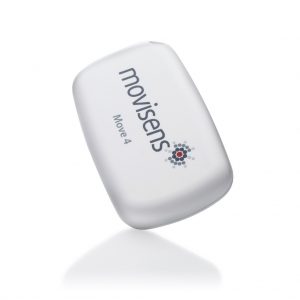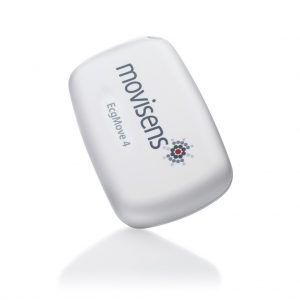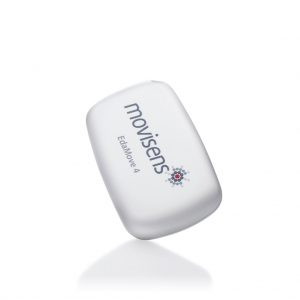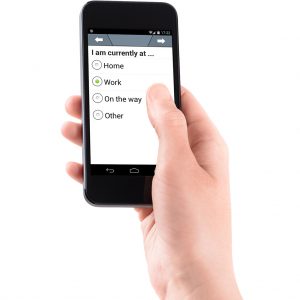SensorTrigger – movisensXS-Feature for Interactive Assessment
Ever wanted to gather more insight into your participants day to day life?
Utilising our German made range of activity monitors allows you to ask a question based on physiological data gathered by the sensors. movisens offers the only research grade sensor triggering functionality for Experience Sampling studies.
This feature allows you to capture the contextual information from a participant, enabling you to fully understand the objective physiological data. Instead of looking at the data and wondering what that spike or dip was in a particular metric, you can use this feature to ask the participant themselves at the moment it occurs.
We’re the only company in ambulatory assessment with class leading products in objective AND subjective measurements. Our research grade sensors analyze physiological parameters as the sensor gathers the data, and then transmits the results via BluetoothSmart to a smartphone installed with movisensXS.
movisensXS evaluates the data within your customisable algorithm, and as a result of the evaluation, can trigger a questionnaire or an intervention on the smartphone.
Whether Interactive Ambulatory Assessment (IAA), Ecological Momentary Assessment (EMAs) or Ecological Momentary Interventions (EMIs), with movisens you’ll realize innovative research ideas and capture insightful data at the right time, in real time and in everyday life.
Using our simple drag and drop interface, you select what physiological parameter (or parameters!) you’d like to utilize and build your own triggering algorithm. When investigating physiological changes such as high activity levels, sedentary behavior, changes in heart rate variability (RMSSD), heart rate thresholds, or electrodermal activity, these parameters can act as triggers within your study.
You have the freedom to select different algorithms for each individual participant, and also further customize the existing algorithms within groups. There's a range of existing algorithms developed for specific research projects that provide a small sampling of what is possible with this innovative technology.
If you have an existing algorithm that you would like to utilize, or an idea for a physiological marker that you would like to have as a trigger, please contact us to discuss its implementation.

Would you like to receive specific information on the topic of sensor triggered experience sampling?
Then take the opportunity and watch one of our webinars. Our webinars also answer questions about planning a study and how to use our products.
Intergration Capabilities
Depending on the choice of sensor, the following parameters can be utilised with the SensorTrigger:
- Movement Acceleration
- Heart Rate
- HRV RMSSD
- HrvIsValid
- Step Count
- Metabolic Equivalent of Task (MET)
- metLevel (metSedentary, metLight, metModerate, metVigorous)
- Light (red, green, blue, clear, ir)
- Interactive coupling of physiological sensors with movisensXS
Applications
- Interactive Ambulatory Assessment
- Intervention Studies
- Activity triggered eDiaries
- Sedentary Behaviour Studies
- Behavioral Monitoring
- Psychological/Physiological Studies
- Event Contingent Sampling
- Rehabilitation Studies
- Effect of Physical Activity on Affect
Matching products and services
Downloads
| Newsletter |
|
|---|---|
| Documentation |
|
Literature and Validation
- Lightweight Visual Data Analysis on Mobile Devices - Providing Self-Monitoring Feedback.
- Contributions à l’élaboration d’un système d’aide médico-sociale à l’aide d’un robot humanoïde.
- Situationsadaptive Navigationsassistenz für Menschen mit Demenz.
- Real-Time Management of Multimodal Streaming Data for Monitoring of Epileptic Patients.
- Bewegungsangst bei chronischer Herzinsuffizienz – Erste Ergebnisse zur Validierung eines Messinstruments..
- Fitness, kognitive Leistungsfähigkeit und Wohlbefinden bei jungen Erwachsenen - Interventionsstudien zum Einfluss von Ausdauertraining.
- Validation and comparison of two methods to assess human energy expenditure during free-living activities.
- Erfassung körperlicher Aktivität mittels Akzelerometrie - Möglichkeiten und Grenzen aus technischer Sicht.
- Home-based system for physical activity monitoring in patients with multiple sclerosis (Pilot study)..
- Detection of Parameters to Quantify Neurobehavioral Alteration in Multiple Sclerosis Based on Daily Life Physical Activity and Gait Using Ambulatory Assessment.
- Using Support Vector Regression for Assessing Human Energy Expenditure Using a Triaxial Accelerometer and a Barometer.
- A Comparison of Two Commercial Activity Monitors for Measuring Step Counts During Different Everyday Life Walking Activities.
- The Association between Short Periods of Everyday Life Activities and Affective States: A Replication Study Using Ambulatory Assessment.
- Characteristics of the activity-affect association in inactive people: an ambulatory assessment study in daily life.
- Acute and medium term effects of a 10-week running intervention on mood state in apprentices.
- Classification of Human Physical Activity and Energy Expenditure Estimation by Accelerometry and Barometry.
- Measurement of daily mobility under fampridine-therapy with Movisens-system in patients with multiple sclerosis.
- Assessment of Human Gait Speed and Energy Expenditure Using a Single Triaxial Accelerometer.
- Aktuelle Messverfahren zur objektiven Erfassung körperlicher Aktivitäten unter besonderer Berücksichtigung der Schrittzahlmessung.
- Kindergarten in Bewegung. Zur Qualität von Bewegungskindergärten..
- Assessment der Mobilität im Alltag zur Unterstützung von MS-Patienten.
- A new method to estimate energy expenditure using accelerometry and barometry-based energy models.
- Estimation of energy expenditure using accelerometers and activity-based energy models - validation of a new device.
- Trends und Möglichkeiten zur Erfassung körperlicher Aktivität im Alltag.
- Einsatz sensorgestützter Verfahren im Gesundheitswesen: Herausforderungen und Lösungsansätze.
- Bewegungskindergärten: empirische Befunde und praktisches Wissen.
- Energieumsatzmessung mit Aktivitätssensoren – Validität des kmsMove-Akzelerometers.
- Validity of the kmsMove-sensor in calculating energy expenditure during different walking intensities.
You can find more publications here.







